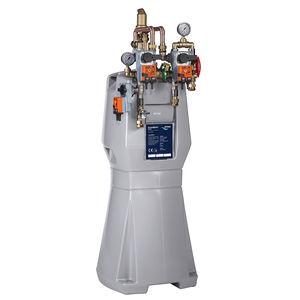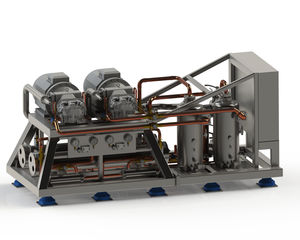
- Maritime equipment
- Interior fittings
- Ship water chiller
- Heinen & Hopman

- Company
- Products
- Catalogs
- News & Trends
- Exhibitions
Ship water chiller
Add to favorites
Compare this product
Characteristics
- Options
- for ships
Description
The absorption chiller uses hot (waste) cooling water from the diesel engines – normally disposed of over board – to produce chilled water serving the HVAC installation. As absorption chillers use heat to drive the refrigeration cycle, they only consume a small amount of electricity to run the pumps on the unit. Absorption cooling can result in energy savings of up to 95%. Absorption chillers generally use steam or hot water to drive the lithium bromide refrigeration cycle but can also use other heat sources.
HOW IT WORKS
An absorption cooling cycle relies on three basic principles:
When a liquid is heated it boils (vaporizes) and when a gas is cooled it condenses.
Lowering the pressure above a liquid reduces its boiling point.
Heat flows from warmer to cooler surfaces.
Absorption cooling relies on a thermochemical ‘compressor’. Two different fluids are used: a refrigerant and an absorbent. The fluids have high ‘affinity’ for each other, which means one dissolves easily in the other. The refrigerant – usually water – can change phase easily between liquid and vapor and circulates through the system. Heat from a hot water boiler, steam or a waste heat source drives the process. The high affinity of the refrigerant for the absorbent (lithium bromide) causes the refrigerant to boil at a lower temperature and pressure than it normally would and transfers heat from one place to another.
Catalogs
No catalogs are available for this product.
See all of Heinen & Hopman‘s catalogsExhibitions
Meet this supplier at the following exhibition(s):

Related Searches
- Handler
- Ship handler
- Bilge blower
- Ship blower
- Ship air conditioning system
- Boat air conditioner
- Air handler
- Monobloc air conditioning system
- Refrigeration unit
- Yacht air conditioner
- Treatment system with filter
- Ship water chiller
- Self-contained air conditioning system
- Yacht treatment system
- Ship fan coil unit
- Purifier treatment system
- Ships heater
- HVAC system
- Ship HVAC system
- Ship fire damper
*Prices are pre-tax. They exclude delivery charges and customs duties and do not include additional charges for installation or activation options. Prices are indicative only and may vary by country, with changes to the cost of raw materials and exchange rates.





